
Ghezireh Palace (Cairo Marriott)
The Ghezireh Palace was the former Palace of Khedive Ismail and consists of three palaces of unrivalled beauty, surrounded by gardens, containing many choice tropical plants, grottoes, fountains and miniature lakes, the whole covering an area of upwards of 245,000 square metres, equal to, say, 60 acres. This magnificent building, which was erected and furnished at immense cost, is situated within ten minutes of the central quarter of Cairo, and its large and luxurious apartments re eminently adapted for families making a long stay. The ancient Kiosk of Ismail Pasha, on the borders of the lake, which is in the gardens of the Palace, has been transformed into a splendid casino, containing magnificent ball and reception rooms, and is patronised by the elite of Cairo Society. The tenure of the property is freehold.

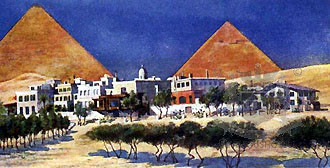
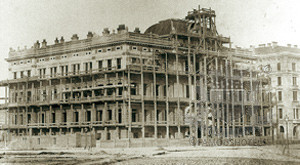
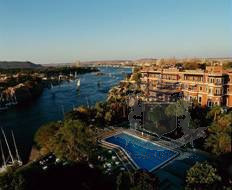
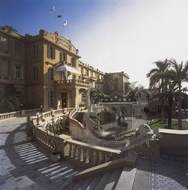
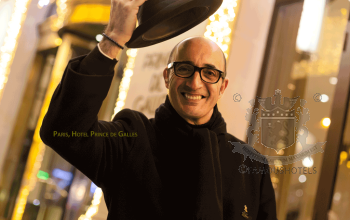
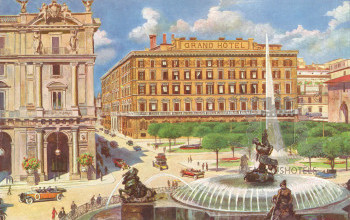
HISTORY IN BRIEF
1868: Opening of the Gezira Palace. 1970s: The hotel was taken over by Marriott.
HISTORY IN DETAIL
1863: With celebrations for the inauguration of the Suez Canal coming up, Khedive Ismail was desperate to dazzle French Empress Eugenie, who, as a cousin of the maker of the canal, Ferdinand de Lesseps, had agreed to open the event. He decided to build a lavish palace for her, where the decoration of her own apartments at the Tuillerie Palace would be duplicated. Construction began in 1863, with the Khedive engaging the services of German architect Julius Franz (later Franz Bey). The palace was influenced by Islamic architecture in the use of marble and mashrabiya work. 1868: Construction was completed with the help of Abdin Palace designer De Curel Del Rosso. The interior of the palace included the most luxurious fittings that could be imported from Paris at the time. French landscape architect Barrillet Deschamps was encouraged to transform the entire island into a formal park, incorporating the existing palace and kiosk of Mohamed-Aly into the gardens. The U-shaped salamlek combined baroque European style with traditional Islamic decorative motifs and architectural features, using "high rectangular windows and corniches of the Renaissance period beside Islamic horseshoe arches. All of the arches, of cast iron, were produced in Germany and assembled in Cairo by German workers brought to Egypt expressly for that purpose. The German designer Carl Wilhelm von Diebitsch decorated the building by prefabricating the furniture, draperies and other internal fittings as well as the gilded stucco decorations in his workshop in Berlin. Once finished, the items were assembled and packed into containers which traveled from Berlin to Trieste by train, then to Alexandria by boat and finally to Cairo once again by train. Many of von Diebitschl's decorative elements have been preserved to this day and can be observed in several of the Marriott's ballrooms. According to Aly Mubarak, minister of public works under Ismail, the palace had cost more than three quarters of a million Egyptian pounds, a considerable amount for the time. This amount excluded the landscaping, in itself a colossal enterprise which entailed reinforcing the banks of the river and protecting the large area around the palace from floods. Only when this work had been completed could Franz lay the foundations of the 147 meter-long palace, which nestled in the middle of the gardens. Once the work was finally concluded, Franz decreed it "the most beautiful building of modern Arabic style in its category". 1880: Ismail's creditors claimed his possessions, and the palace was sold to a hotel chain. It became known as the Gezira Palace hotel, which rivaled in luxury the famous Shepheard's and was for a while under the same management. The gardens were divided between the Khedival (later the Gezira) Sporting Club, encompassing the race course and polo field which had previously surrounded the royal residence, 1902: Ismail’s old fish grotto was turned into a garden featuring rare trees and an aquarium and opened officially to the public that year. 1908: Around that time, the hotel was sold to Prince Michel Lutfallah, who transformed it into a private residence. 1952: After the revolution, the hotel was sequestrated. 1962: The palace was turned into the Omar Khayyam hotel, which featured unsightly green and yellow makeshift cabins all over the garden. 1970s: The property was handed over to the management of the Marriott hotels, who restored the original palace, equipping it with all the amenities befitting a five star hotel. Two skyscrapers were also built to handle increasing demand.
The hotel was built to impress a very important guest, Empress Eugenie of France, who came to Cairo to open the Suez Canal.
High-Speed Internet Minibar Safe box Hair dryer Cable TV Balcony Individual climate control Revive, the new bed from Marriott with down comforters, designer duvets and fluffier pillows
The hotel has 10 different restaurants, including the American-style JW's Steakhouse, the Fish Market, and the Nile Maxim. There are also five bars, including Harry's Pub, the Casino's Omar El Khayyam bar, and a piano bar.
Take advantage of the six acres of lush gardens around the hotel.
Health and fitness center with a whirlpool, sauna, massage service and gym. ------ Large outdoor pool ------ Three floodlit tennis courts.